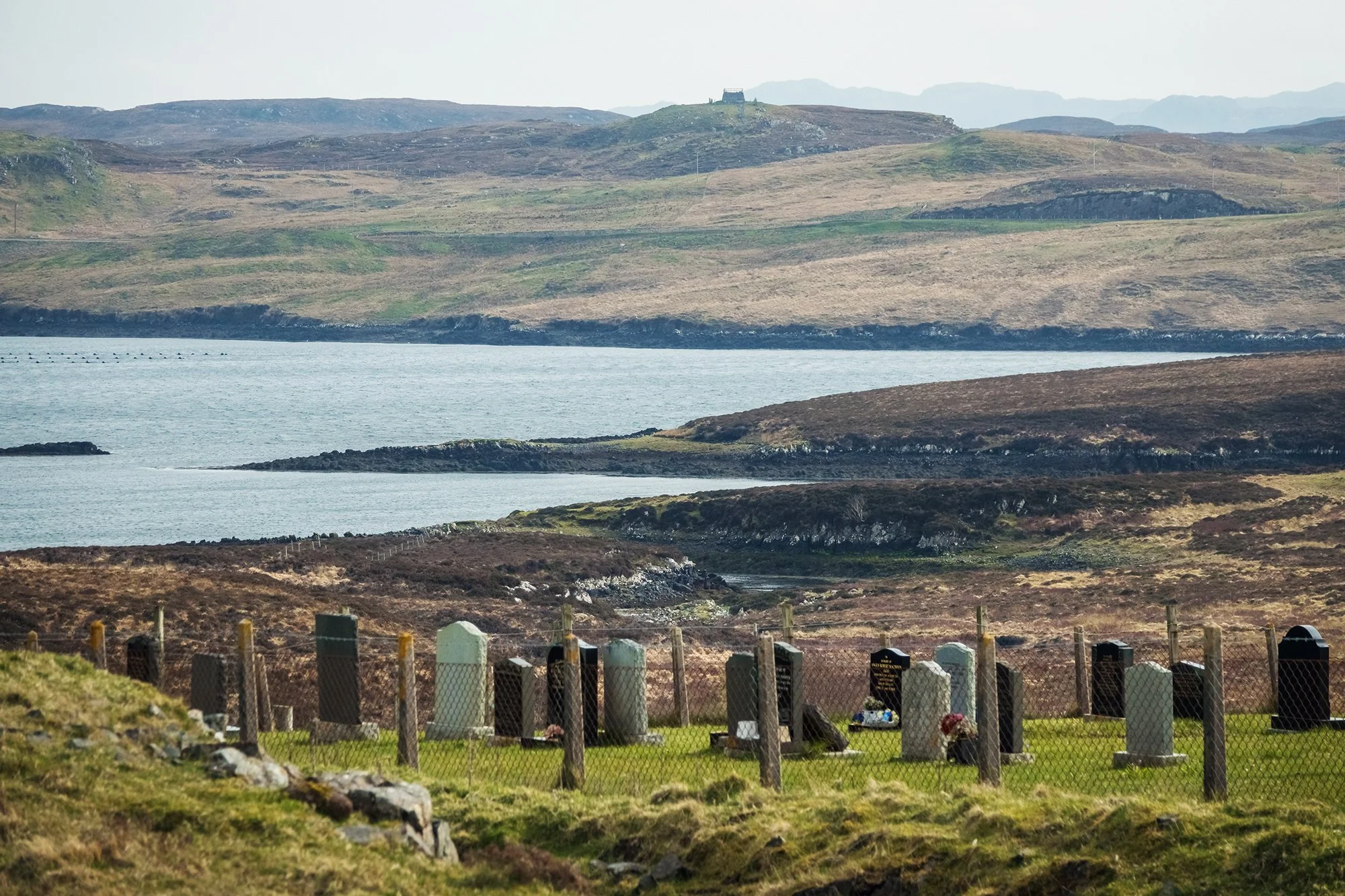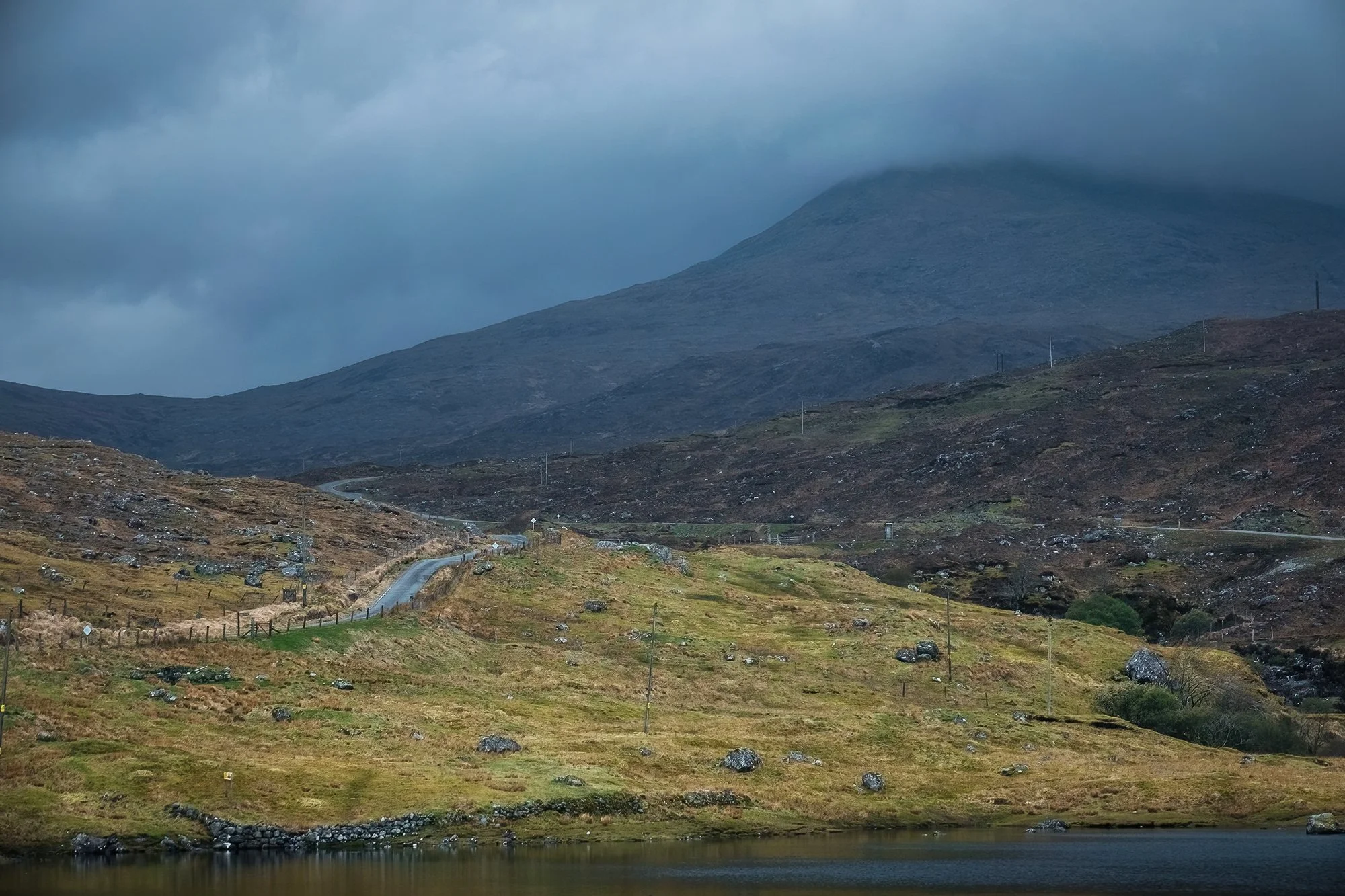“There, laid out far below you, still miles away but radiating its life and beauty across the intervening air, is something else… no longer the sour, tweedy dun of the acid moorland and its ribs of gneiss, but an unmatched set of the most beautiful colors in the world: the iron gray of the Atlantic transmuting into dark blue, then paler blue, then a dazzling, flickering turquoise which from time to time flashes pure white as a breaking wave slowly unfolds onto the white sands of the most perfect beaches in Europe. It is a vision of paradise seen from hell… It is the sort of place, as you walk these miles of empty beach, as the wind blows in off the Atlantic, where you remember again what the point is of being alive.”
- Adam Nicholson
Foreword to Seasons on Harris
“Her voice rang around the rafters of the church, clear and pure and unaccompanied. The doors were open so that those outside could hear her, and in the still of this sad grey morning, her voice drifted out across the loch, a plaintive lament for a lost friend and lover.”
- Peter May
The Chessmen
Ten years. That’s how long this one has been in the works. Ever since I started planning our first (engagement) trip to Scotland in 2015, I’ve had my eye on the Outer Hebrides, the long, rock-strewn, water-bound archipelago that represents the pinnacle of wildness on Scotland’s western coast. At that time, it seemed so far, so unreachable and lonely, and we didn’t have the time to make the ferry crossing and do it justice, so we settled for gazing at its distant silhouette from across the Minch, standing one evening at sunset on the western tip of Skye. Later that week, in the National Gallery in Edinburgh, as I gazed upon giant oil paintings of Hebridean landscapes, my heart was filled with longing and I vowed someday to be back.
So you can imagine my emotion as we approached the Isle of Lewis, passing over the long stretches of unbroken moorland studded by little lakes and lochans, flying by crystalline sandy shores, and finally gliding down onto the tarmac of the little airport in Stornoway. It’s been a long overnight stretch of travel for me, with two connections in Heathrow and Glasgow, but I am thrilled to finally be back in northern climes. In the one-room airport terminal, I quickly secure my bag and my rental car keys and head out into windswept, overcast, but bright and beautiful afternoon.
After settling into my blood-red Kia Ceed (which I name La Pasionaria, after a republican woman-leader in the Spanish Civil War; in case you haven’t noticed, the personification and naming of the rental car has become an impressionistic, spontaneous affair for me over the years). I carefully navigate my way (“on the left, on the left, on the left…”) into town to pick up groceries at the local Co-op supermarket. It’s a crowded, bustling place on this Saturday afternoon, as most of the local folk still get their shopping done before observing the Sabbath on Sunday. I pick up the usual: fresh fruit, bread buns, cheeses and yogurts, juice and milk to-go, some canned vegetables to go with dinner, a tin of hot cocoa mix (a treat which I feel I fairly deserve tonight), those memorable custard tarts (how I haven’t missed them, since they are nearly identical to what the British and Portuguese contributed to Southern China’s dim sum scene), and hot chicken and shepherd’s pies from the bakery counter. Then, it’s off on a long drive southward to the hills of North Harris, where I’ll be staying for three nights in a fishing hut by the water.
Along the way, I contend with La Pasionaria’s spectacularly annoying lane assistance settings, which keep jerking me this way and that way on the curving, narrow island roads. I pull off by the roadside several times to take my first photos of this vast, haunting island landscape. Climbing past the forests near the Ardvoulie Estate along the shores of Loch Seaforth, the road suddenly brings me face-to-face with North Harris’ mountain walls, which look impressively moody in their afternoon finery of dark clouds and scattered light. A final left turn toward Loch Màraig, and I arrive at my new home.
In the fisherman’s hut (little more than a tin-roof shed on the outside, but furnished so comfortably and cozily on the inside), I get settled in and have a bite to eat while taking in my surroundings. There’s no Wi-Fi and precious little cell service (I am able to sneak a rare text out to let Jane know I’m okay), so it’s a perfect place to spend a few days off-grid, enjoying the island scenery and soaking in my solitude at the water’s edge. After a brief rest, I head back out in the early evening and continue along the narrow track beside the loch (a former post route, now built into a road) up the hills and through a valley, past a series of dark, clear lochans studded like beady gems beneath the shadow of Tòdun. Above the village of Rhenigidale, I step out to photograph the wild coast, the hamlet tucked against the hillside, and the blooming gorse and early heather. In the distance across the water, I can make out the faint but unmistakable outline of the Shiants; and how nice it is, finally, to see them from the other side of the Minch, which is wind blown and tempestuous today, as it so often is. After taking in the stormy views and wandering down to the village youth hostel, I retrace my way back up the post route, stopping along the way to document the views. The hills to the west are completely cloud-socked, and soon rain begins to fall. Back at the hut, I take an early(ish) night, and after making myself dinner and showering, I finally fall into deep sleep after nearly thirty hours of continuous travel, to the sound of rain gently drumming on a tin roof.

































